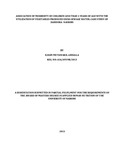| dc.description.abstract | Use of wastewater for growing vegetables has become a common practice among the Nairobi residents living in slum areas. Indeed, a good number of the city’s residents ignorantly feed on these food crops grown in the sewer despite experts warning that they could have adverse effects on them. Farmers in Dandora have been seen to be using sewage water for irrigating vegetables especially within the slum area. This study aims at establishing the health risks paused by vegetables grown using sewage water, and nature of morbidity patterns among children less than 5 years of age. The study design was cross sectional and analytical in nature. Data collection was done through interviews and laboratory analysis. For the face-to-face interviews, questionnaires were administered among mothers who had children less than 5 years of age and consumed vegetables grown using sewage water. For laboratory analysis, sewage water, soil and vegetable samples were taken from gardens that irrigated with sewage water. These samples were analysed for the presence of bacteria, parasites and heavy metals. The study revealed that 78.8% of the households grew vegetables, while 85.3% sourced their water from sewerage and drainage systems for irrigation. 93.9% of these households did not treat the sewage water that was used for irrigation. The results on heavy metals, bacteria and parasites showed that although the water samples were not as heavily contaminated with metallic elements as the soil samples, both were contaminated with bacteria and parasites. The vegetables, the garden, the market and cooked ones at households presented no parasites and minimum exposure of metal elements in these leafy vegetables. Presence of bacteria was noted in fresh vegetables (from the garden and market) but the cooked vegetables showed no bacterial contamination. The study revealed that most common illness affecting the children less than five years of age was cough/ colds. There was an association between feeding children with vegetables grown using sewage water and diarrhea (P= 0.575; = 0.01) and cough/ cold (P=0.360; = 0.01). The study’s conclusion was that there was a significant association between morbidity (Diarrhea and coughing/cold) of children less than five years of age and feeding of Sukuma wiki grown using sewage water in Dandora. | en_US |



